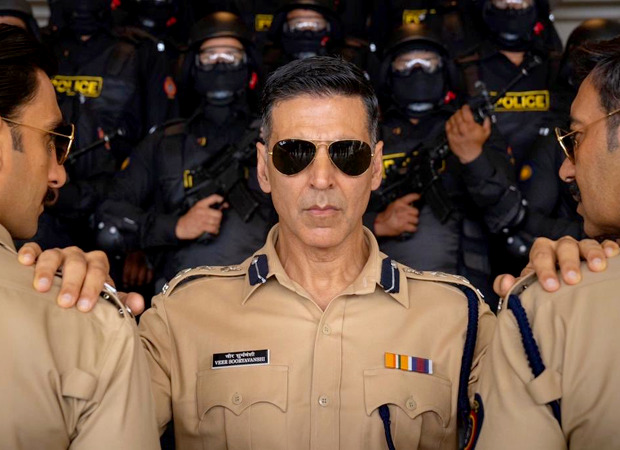Sooryavanshi-theatre row: Exhibitors ask for pre-Covid revenue sharing; flexibility in shortening of OTT window
Bollywood Hungama yesterday reported that the makers of Sooryavanshi, which is scheduled to release on April 2, have asked for 70% revenue share from the multiplexes. As per the pre-Covid era arrangement, the producers used to get 50% share. Also, they have asked for shortening of OTT window from 8 weeks to 4 weeks. The exhibition sector, however, hasn’t agreed to these conditions yet. The revenue sharing model, according to them, is not financially feasible for the theatres. Also, many theatre owners fear that if films arrive on digital in just 4 weeks, it can reduce footfalls. But with Tamil blockbuster Master (2021) arriving on Amazon Prime in 16 days, a precedent has already been set.

Then there’s also the issue of virtual print fee (VPF). It is an amount, usually Rs. 20,000 per screen, which is charged by multiplexes, and by a third party in case of single screens, to the producers for upgrading their projection system for a better cinematic experience. Many producers believe that charging VPF is no longer necessary as the theatres have recovered the cost. Also, the fact that it’s charged from only the Indian films and not from Hollywood flicks has been a bone of contention between them for a long time. The makers, thus, want exemption from VPF.
Should the OTT window be shortened from 8 weeks to 4 weeks?
We asked three exhibitors their views and expectations with regards to these issues. Raj Bansal, the owner of Entertainment Paradise in Jaipur, said, “(OTT window) 8 weeks ka hi rehna chahiye. Anything less than that is being unfair with the exhibitors and distributors. For a small film, a four-week window between theatrical and digital is okay. But big-budget films do run for 6 to 8 weeks and to release them within 4 weeks is absolutely unjustified. If I come to know that I can watch a particular film online after a couple of weeks, I’ll try to avoid going to the theatres. It’ll majorly hamper our business.”
Vishek Chauhan, owner of Roopbani Cinema in Bihar, however, remarks, “Reduction of OTT window from 8 to 4 weeks doesn’t make a difference. Even Wonder Woman 1984 (2020) had released on SVOD (subscription video-on-demand), and not on PVOD (premium video-on-demand). It was released later in cinemas as it began to stream from midnight. It was cold and Covid-19 was at its peak. Still, it managed to collect $16.7 million at the North America box office on the weekend. When Master hit Amazon Prime, the collections in the cinemas in that week were very strong. The drop was normal, not an alarming one. Cinemas don’t compete with OTT platforms. Secondly, we have been competing with piracy for the longest period of time. I’ll share one incident with you. I was running Sultan (2016) in my theatre. In the restaurant next door, which was also run by me, I saw three guys watching the same film, Sultan, on their mobile phones. I felt bad. But I understood that that audience is different. The theatrical audience doesn’t really care if a particular film would arrive on OTT. In our country with a 135 crore population, even if 2% of people watch a film in cinemas, it becomes a blockbuster. Hence, I don’t feel the reduction of OTT and theatrical would make much of a difference, because those who want to watch a film in cinemas would anyway do so, come what may.”
He has an interesting solution for this tiff, “Variable windowing should come into play. The one-size-fits-all model is not practical. For example, a film like Ramprasad Ki Tehrvi (2021) was a non-starter from the first day. Why should the producers hold back the film from digital for 4 weeks or 8 weeks? Let it release on a streaming platform in 2 weeks’ time. I believe that the collections in theatres should decide when a film should release digitally. If a film is running strong in cinemas, then its digital premiere should be postponed. There should be a threshold mark – say that if a film starts collecting less than Rs. 15 crore or Rs. 10 crore in a week, then it’s fit to go on OTT.”
He continues, “This would enable the producers to earn more. And if they earn more, they will in turn, make more films. So let’s not become enemies of each other. Let’s be smart and help the movie business grow. The perception that audiences will stop going to cinemas is a myth. Master has shown that theatre business is alive and kicking and that cinemas will always be around.”
Akshaye Rathi, film exhibitor and distributor, agrees as he says, “There should be a degree of flexibility. Ideally, it should be a minimum 4 weeks to start with. It’s not completely normal yet and it’s important that producers and exhibitors watch each other’s backs rather than just look at their individual interests. We’d love it if the producers give us a chance to optimally perform with the business of Sooryavanshi and god forbid if it underperforms, then I think it’s only right that the producers to expect exhibitors to allow them to release on OTT earlier than the normal old-school window of 8 weeks. So that sort of flexibility and give-and-take is important, at least for a couple of months or for the first few big-ticket Hindi film releases that come out.”
Zee has its PVOD portal, ZeePlex, and the first significant film to release post lockdown, Suraj Pe Mangal Bhari (2020), arrived on this platform in a month’s time. It’s only after 8 weeks that it made its way to Zee’s OTT platform, Zee5. Raj Bansal is fine with this arrangement and states, “India is not yet ready for pay-per-view subscription. I would prefer a film releasing on a pay-per-view channel than on OTT release, before 8 weeks. It does not affect me much.”

Should VPF go away?
As for VPF, Akshaye Rathi says, “These conversations can’t happen in an isolated manner. VPF is a complicated matter. The national chain of multiplexes themselves charges the VPF. In the case of the single screens, there’s a third party called UFO that collects the fee. So it has to be a tri-party conversation and only then can a mutually suitable solution be arrived at.”
Meanwhile, Vishek Chauhan begins in a lighter vein, “As far as I know, India is the only country where VPF is a revenue model. Hum log projector se paise kamate hai!” He then suggests, “You can’t overnight force the VPF system to be discontinued. If that happens, then it’ll greatly affect UFO Movies and in turn, it’ll affect the survival of single screens and standalone multiplexes. So I agree that there should be a sunset clause. You can’t expect filmmakers to cough up Rs. 20,000 per film per theatre for life. So VPF should go in a phased manner so that it doesn’t hurt people. This would give them time to explore other streams of revenue generation like bumping up logistics or cloning charges; or maybe, advertising can go bigger, etc.”
Will higher revenue sharing for the producers be the norm in post-Covid era?
Finally, speaking of revenue sharing, the exhibitors feel that in the long run, the makers won’t be able to demand higher terms. Vishek Chauhan exults, “The success of Master and Krack has kickstarted the business down South. The same would happen in Bollywood with Sooryavanshi. So the first film might be paid more in terms of revenue. Its makers can bargain as there’s no other big film around. But once it emerges as a success, I believe this revenue sharing discussion would stop once and for all. Speaking of Sooryavanshi, by postponing for a year, their budget must have increased by Rs. 15-20 crore. So even they need to recoup their costs, right?”
He also lists out the consequences of this new practice, “The higher revenue share for makers would not be in the interest of the trade as well. Because if this arrangement is not profitable, then many theatres would get shut. If every film starts charging 65-70% revenue, then the exhibitors would not make enough money to cover costs or generate profit. Also, it’ll put a question on future investment. So people would not invest in cinemas or upgrade their properties. There was a lot of thought that had gone into coming up with a 50:50 revenue sharing model.”
Vishek Chauhan also states another possible future scenario, “If two highly anticipated films come on the same day, and if one asks for 70% revenue while the other one agrees with the normal pre-Covid era rates, then obviously the exhibitors would be interested to screen the latter film.”
Akshaye Rathi opines, “Increase in revenue sharing will be a short term thing. With due respect, as much as producers have waited, even the exhibitors have waited and have paid revenues, maintenance charges, electricity bills etc. So rather than trying to prove that you are doing a favour to us or we are doing a favour to you, we need to look at the fact that without the existence of this ecosystem, all of us would collapse. Everyone has made sacrifices. Now is the time to stand by each other and help each other rebuild the business as soon as possible.”
Will we go back to the old model?
Raj Bansal is of the firm belief that in time, everything will be just like before – revenue sharing will be done as per the old model and films would go on OTT only after 8 weeks. He says, “If normalcy comes through soon and Sooryavanshi does release in April, then the next 9 months would be historic in terms of box office collections! So it’ll back to normal in all respects. There’s so much of backlog. No one will get a solo release. For festive weekends, there’d be 3 releases and for non-festive weeks, there are chances that there’d be at least 2 releases.”
Vishek Chauhan, meanwhile, predicts, “Agar woh (Sooryavanshi makers) 70% revenue maang rahe hai, tab jaa ke 60% pe baat done hogi. If they had asked for 55%, multiplexes would have insisted on 50%. So I believe they’d decide on 55-60% at the end of the day, for multiplexes. Non-national multiplexes and single screens might agree for 5% higher.”
However, the discussion won’t get ugly. There’s genuine respect and understanding of the condition of each other. Raj Bansal signs off by saying, “I’d like to thank the producers of Sooryavanshi. They stood by the exhibition industry and delayed its theatrical release by a year. We must appreciate that gesture.”
Also Read: REVEALED: Sooryavanshi makers ask for 70% revenue share from multiplexes; 4-week OTT window
from Latest Bollywood News | Hindi Movie News | Hindi Cinema News | Indian Movies | Films - Bollywood Hungama https://ift.tt/36KR3Up
No comments:
PLEASE DO NOT ENTER ANY SPAM LINK IN COMMENT BOX